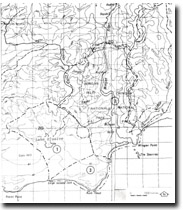8722-3 Rame Head
|
This information has been developed from the publications:
|
Location: | 188161. Three kilometres south-west of Wingan Inlet. |  Sites 8722 1, 2, 3 |
Abstract: | Dune covered granite headland. | |
Access: | Coastal walk from Wingan inlet. | |
Ownership: | Crown Land (Croajingolong National Park) | |
Geology: | Strongly jointed Maramingo Granite forms this major headland south-west of Wingan inlet. Small basic dykes are common on the eastern side (12). The granite is overlain by deep Quaternary dune sands. | |
Geomorphology: | The coastline is steep and rocky and deeply dissected by clefts and gutters eroded along joint planes in the granite. Beach development is minimal. The sands that overlie the granite are cliff top dunes (14) are confined to small areas on the western side. | |
Significance: | Regional. This is one of the best examples of stabilized cliff top dunes in East Gippsland. The dune stratigraphy has not been investigated. | |
Management: | Minimal disturbance to dune vegetation is necessary to maintain the stabilized dune ridges. | |


